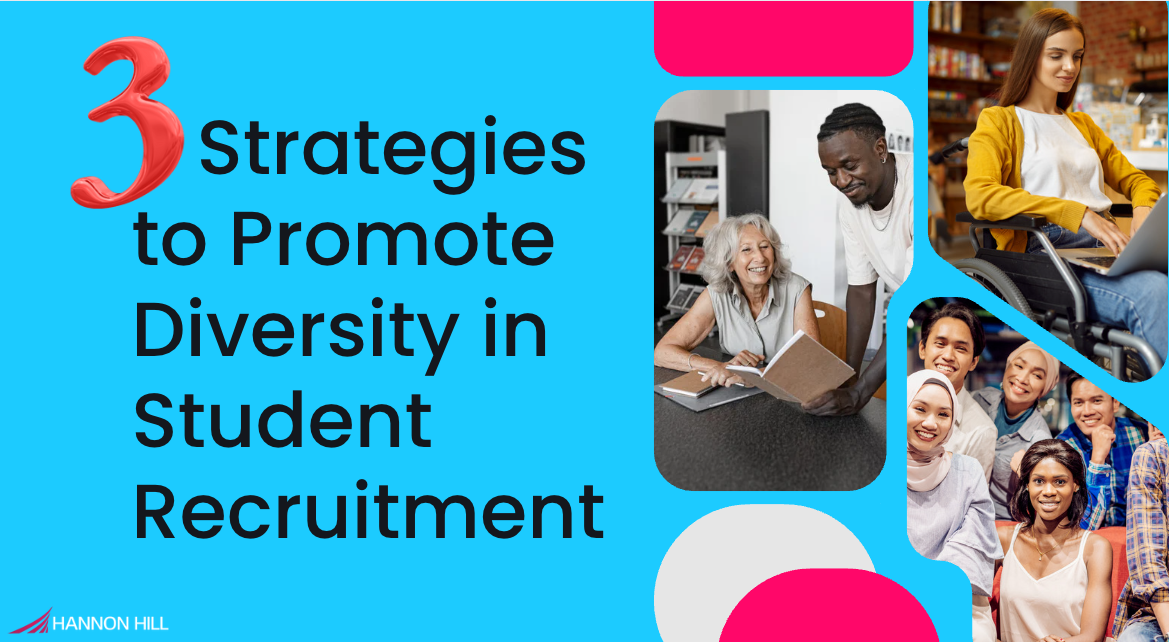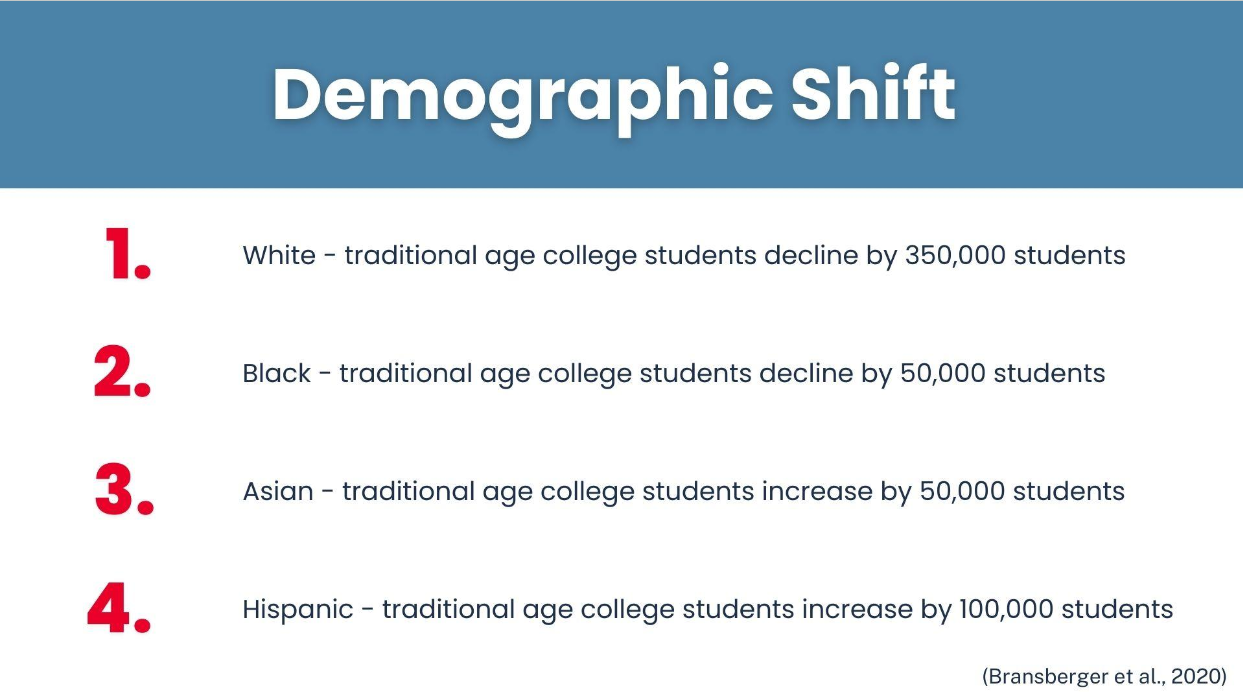
For the purpose of this blog post, we focused on racial and ethnic minorities, students with disabilities, and adult and non-traditional students. We realize that these are not the only diverse groups and plan to focus on them in upcoming blog posts.
As colleges and universities strive to bridge the demographic enrollment cliff, the emphasis on creating a diverse environment for students from all backgrounds has never been more critical.
Colleges and universities that have been affected by this precipitous drop-off in diverse student enrollment have suffered. Research has shown, and leading educational experts concur, that an increase in diversity on college campuses is a net positive for students.
According to the American Council on Education, diversity in higher education “enriches the educational experience”, “promotes personal growth”, “strengthens communities and the workplace”, and “enhances America's economic competitiveness.”
In many cases, this issue is exasperated due to well-meaning institutions unintentionally excluding or deemphasizing certain groups in their recruitment efforts or enrollment materials.
While the challenges are many, there is hope for a more diverse, inclusive campus experience. Below are three simple strategies your institution can utilize to help promote diversity in student enrollment and bridge the looming demographic enrollment cliff.
An excellent way to help increase campus diversity and make your institution more inviting to prospective minority enrollees is to include students from a variety of racial and ethnic backgrounds in your institution-wide recruitment efforts.
This can be as simple as inviting minority students to be docents on campus tours, leaders at school information sessions, or instructors at new student orientations.
But why are minority and underrepresented student groups so important for the overall health of an institution?
During a recent webinar on navigation the demographic enrollment cliff, Dr. Carrie Phillips highlighted that while enrollment among both African American and Caucasian students is predicted to decline by 50,000 and 350,000 students respectively from 2025 to 2037, Asian and Hispanic student enrollment is forecasted to rise by 50,000 and 100,000 students respectively during the same time period.

In an effort to prepare for this expected uptick in minority students and foster a more inclusive environment for them, some institutions have begun offering minority and bilingual student orientations geared toward Black, Asian, and Hispanic students.
For instance, the University of Texas at San Antonio now offers a special Black Student Orientation at the beginning of each semester. While the event is designed with students of color in mind, it’s open to the entire student body.
Stanford University hosts a multi-day Asian American New Student Orientation event intended to help new enrollees learn about the Asian American community and services at the school.
Many schools, such as the University of Wisconsin-Milwaukee, also offer bilingual Spanish language orientations for Hispanic students and their families. UWM’s Family Spanish Language Orientation program offers multiple English/Spanish orientations throughout the year.
By placing minority students front and center and encouraging them to lead, as these schools have done, your institution can showcase its strong commitment to diversity, boost minority enrollment, and empower the next generation of leaders.
Another way to promote diversity in your student enrollment is to invite community leaders and luminaries from disability advocacy groups to speak at your institution.
The experience, insight, and knowledge that these leaders bring can often serve as a touchstone for students with disabilities and in many cases, even inspire them to pursue their dreams with the help of higher education.
To launch these conversations, your institution could host a community roundtable with disability advocacy leaders, a listening session with a student accessibility group, or a keynote speaking event with a prominent disability advocate.
To better shine a spotlight on students with disabilities, several schools, including the University of California San Francisco and the University of Texas at Austin, have begun hosting speaker series on disability access and inclusion. During the events, a variety of topics pertaining to learning accessibility, disability access, and inclusive design have been discussed.
According to UT Austin’s Texas Center for Disability Studies, which hosted a recent Disability Awareness Speaker Series, events like these are designed to “provide awareness on different topics and their intersection with disability” and to challenge “the social model of disability … caused by the way society is organized.”
Inviting community leaders from disability advocacy groups to speak at your college or university can be an excellent way to increase your institution’s appeal among students with disabilities. It may even help trigger a deeper conversation about inclusivity in higher education.
An additional way for your institution to showcase its commitment to diversity and help bridge the looming demographic enrollment cliff is by making an effort to feature adult and non-traditional students in your enrollment resources.
This can be accomplished by asking adult and non-traditional students to participate in the creation of resources for your institution, such as photos and illustrations for your enrollment materials, photos and videos for your websites, and content for your social media channels.
Dr. Carrie Phillips, Chief Marketing Officer at the Unversity of Arkansas at Little Rock, recently spoke about the challenges of effectively marketing to non-traditional students in a Hannon Hill webinar, Navigating the Demographic Enrollment Cliff.
According to Dr. Phillips, in order for institutions to appeal to adult and non-traditional learners, they must ensure every student feels welcome and a sense of belonging. This can be accomplished by highlighting diverse student profiles in enrollment resources, including those with different backgrounds, experiences, and study tracks, especially adult and transfer students.
For more information on this topic, check out our recap of the webinar here, or read the whitepaper on the issue, Navigating the Demographic Enrollment Cliff.
By including students and teachers from a variety of ethnic backgrounds in your enrollment resources, websites, and social media channels, your institution will be sending a clear message to the community and your prospective students that diversity and inclusion are important to you.
In order to promote diversity in student enrollment and bridge the looming demographic enrollment cliff, higher-ed institutions must prioritize strategies like the ones outlined above.
While the challenges colleges and universities face are great in their efforts to build more inclusive, inviting campuses, tools do exist to help make the job easier.
Cascade CMS from Hannon Hill is uniquely designed to help higher-ed institutions tailor their messaging, maintain brand consistency, and track their content's health.
If you're interested in learning more about the benefits of Cascade CMS and seeing how Hannon Hill can help your institution take control of its online presence, fill out the contact form below, and a member of our team will be in touch.
Last Updated: Nov 9, 2023 11:00 AM